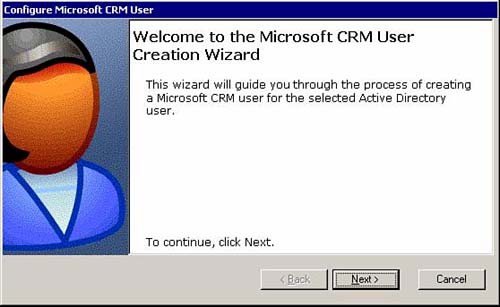Microsoft CRM, Exchange Server, and Active Directory
Microsoft CRM's email integration (the Exchange Connector) is designed to work with the latest version of Microsoft's email server, Microsoft Exchange 2000. In earlier versions of Exchange, users were organized separately between Windows and Exchange. With Exchange 2000 and Active Directory 2000, you set up one organization, therefore you do not have to create users in two different places. After you set up a user in Active Directory, you are asked if you want to give that user a mailbox in Exchange.
For those readers not familiar with Active Directory, think of it as a database used to organize all the resources in the organization. Resources can be users, printers, servers, and so on. Active Directory keeps track of these resources as well as the relationships and access rights between resources. Active Directory is the “big brother” that knows who can get into what and when.
Like Exchange 2000, Microsoft CRM uses Active Directory for its user base. To gain access to Microsoft CRM you must be a user in Active Directory. From there you are assigned Microsoft CRM Roles and given a license to use Microsoft CRM. After you've logged on to your network, you will not need to logon to Microsoft CRM again. Your Active Directory user profile stored the roles you have access to in CRM. This is the main idea behind Active Directory and what is known as Windows authentication. Rather than having different usernames and passwords for every application you use, your access to all applications is associated with your Active Directory user profile.
It's important to note that Microsoft CRM requires a Native mode active directory tree as opposed to a Mixed-mode tree. This is important because Native mode is not compatible with the Windows NT 4 operating system. Therefore, all of an organization's servers must be running Windows 2000 to run Active Directory in Native mode. An alternative to upgrading all servers to Windows 2000 is to create a separate Active Directory tree specifically for Microsoft CRM. You can then create a trust relationship between the main Active Directory tree and the new Native Active Directory tree.
NOTEActive Directory studs will be quick to ask the question, “does Microsoft CRM extend the Active Directory schema?” The answer is no. Active Directory is simply housing the CRM roles and Organization units. |
Microsoft CRM's Deployment Manager tool includes a wizard for adding users to CRM. This tool, called User Manager, enables an administrator to select an Active Directory user and assign it roles and a business unit in Microsoft CRM. Microsoft CRM users can also be created directly in the Microsoft CRM Web client. However, this method does not allow the direct selection of Active Directory users. Figure 5.13 shows the CRM user creation wizard. Deployment Manager is covered in Chapter 11, “Configuring Microsoft CRM.”
Figure 5.13. The Microsoft CRM User Creation Wizard.

